Analysis of Knowledge Management Strategies at Coca-Cola Company
VerifiedAdded on 2020/05/28
|15
|4536
|2122
Report
AI Summary
This report provides a comprehensive analysis of knowledge management (KM) practices within the Coca-Cola Company. It begins with an introduction to KM, emphasizing its role in information storage, data gathering, and organizational development. The report then delves into Coca-Cola's KM infrastructure, including its culture, organizational structure, IT infrastructure (Intranet and Electronic Data Interchange), and physical environment. The analysis further explores the specific technologies employed by the company, such as the Intranet system and electronic data interchange. The report examines how these technologies facilitate knowledge sharing and application. The core of the report assesses the impact of KM solutions on various aspects of the company, including its people, processes, products, and overall organizational performance. The report concludes with an analysis of the effectiveness of Coca-Cola's KM strategies and offers insights into the company's approach to leveraging knowledge for competitive advantage. The report highlights the importance of KM systems for enhancing capabilities and competencies within the organization, with a specific focus on how Coca-Cola has implemented these systems to achieve positive outcomes.
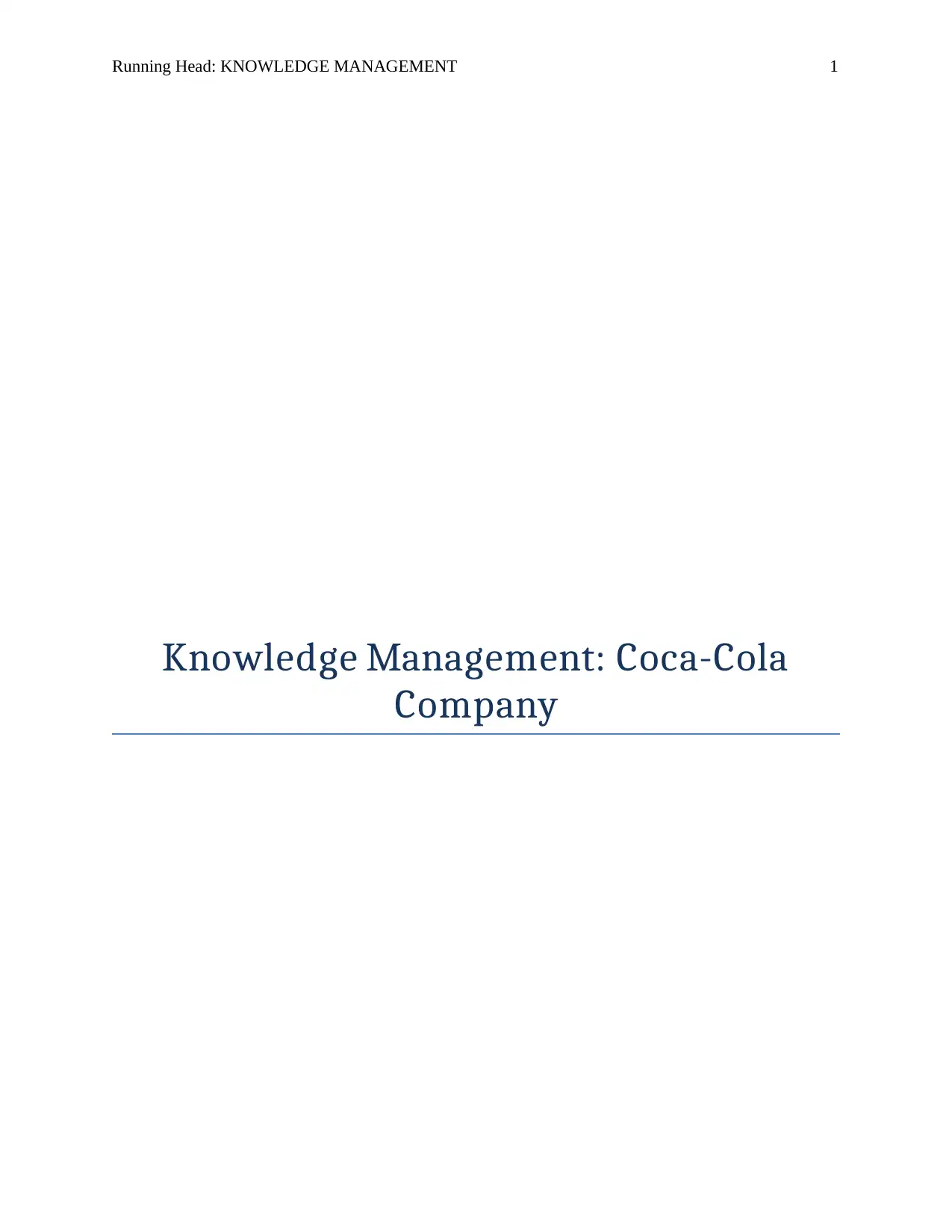
Running Head: KNOWLEDGE MANAGEMENT 1
Knowledge Management: Coca-Cola
Company
Knowledge Management: Coca-Cola
Company
Paraphrase This Document
Need a fresh take? Get an instant paraphrase of this document with our AI Paraphraser
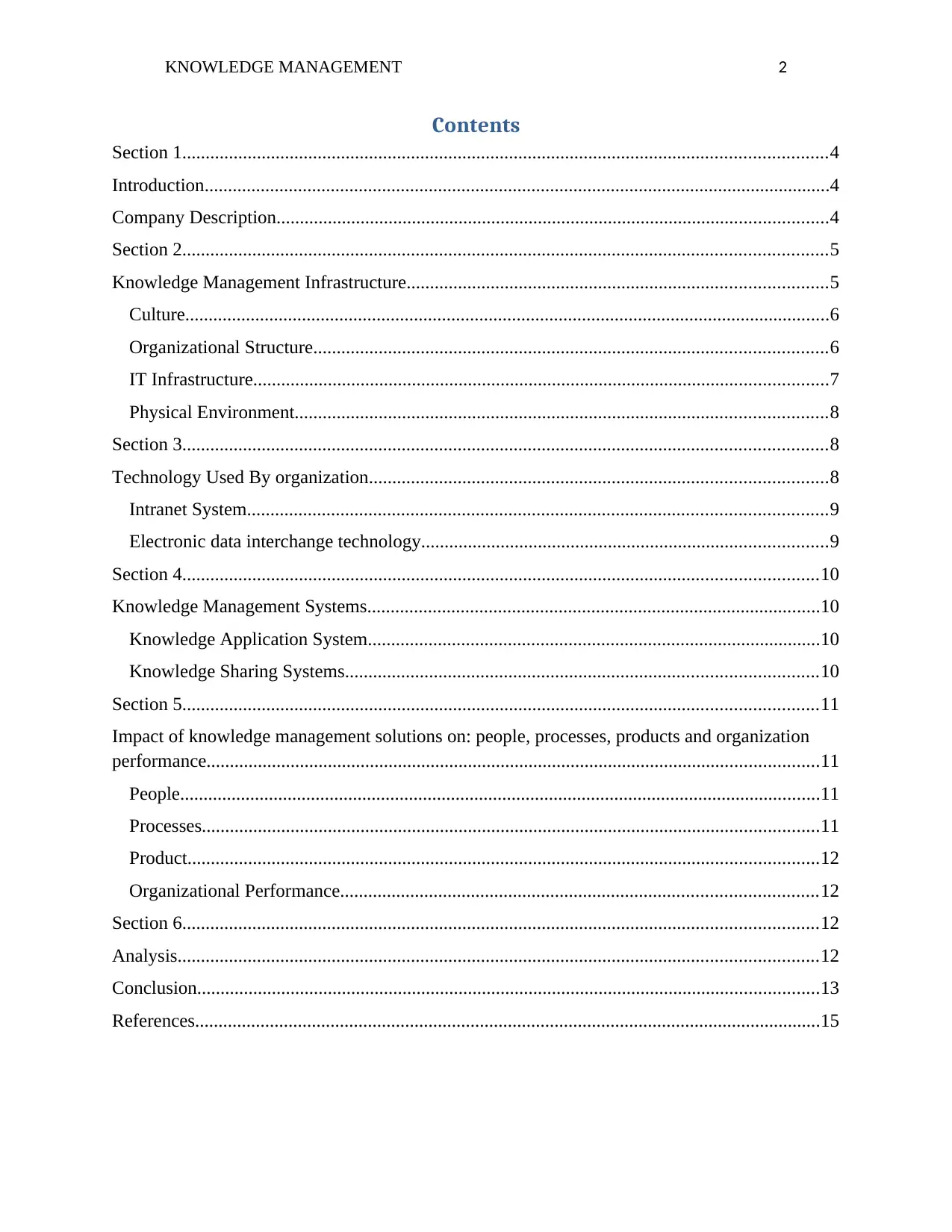
KNOWLEDGE MANAGEMENT 2
Contents
Section 1..........................................................................................................................................4
Introduction......................................................................................................................................4
Company Description......................................................................................................................4
Section 2..........................................................................................................................................5
Knowledge Management Infrastructure..........................................................................................5
Culture..........................................................................................................................................6
Organizational Structure..............................................................................................................6
IT Infrastructure...........................................................................................................................7
Physical Environment..................................................................................................................8
Section 3..........................................................................................................................................8
Technology Used By organization..................................................................................................8
Intranet System............................................................................................................................9
Electronic data interchange technology.......................................................................................9
Section 4........................................................................................................................................10
Knowledge Management Systems.................................................................................................10
Knowledge Application System.................................................................................................10
Knowledge Sharing Systems.....................................................................................................10
Section 5........................................................................................................................................11
Impact of knowledge management solutions on: people, processes, products and organization
performance...................................................................................................................................11
People.........................................................................................................................................11
Processes....................................................................................................................................11
Product.......................................................................................................................................12
Organizational Performance......................................................................................................12
Section 6........................................................................................................................................12
Analysis.........................................................................................................................................12
Conclusion.....................................................................................................................................13
References......................................................................................................................................15
Contents
Section 1..........................................................................................................................................4
Introduction......................................................................................................................................4
Company Description......................................................................................................................4
Section 2..........................................................................................................................................5
Knowledge Management Infrastructure..........................................................................................5
Culture..........................................................................................................................................6
Organizational Structure..............................................................................................................6
IT Infrastructure...........................................................................................................................7
Physical Environment..................................................................................................................8
Section 3..........................................................................................................................................8
Technology Used By organization..................................................................................................8
Intranet System............................................................................................................................9
Electronic data interchange technology.......................................................................................9
Section 4........................................................................................................................................10
Knowledge Management Systems.................................................................................................10
Knowledge Application System.................................................................................................10
Knowledge Sharing Systems.....................................................................................................10
Section 5........................................................................................................................................11
Impact of knowledge management solutions on: people, processes, products and organization
performance...................................................................................................................................11
People.........................................................................................................................................11
Processes....................................................................................................................................11
Product.......................................................................................................................................12
Organizational Performance......................................................................................................12
Section 6........................................................................................................................................12
Analysis.........................................................................................................................................12
Conclusion.....................................................................................................................................13
References......................................................................................................................................15
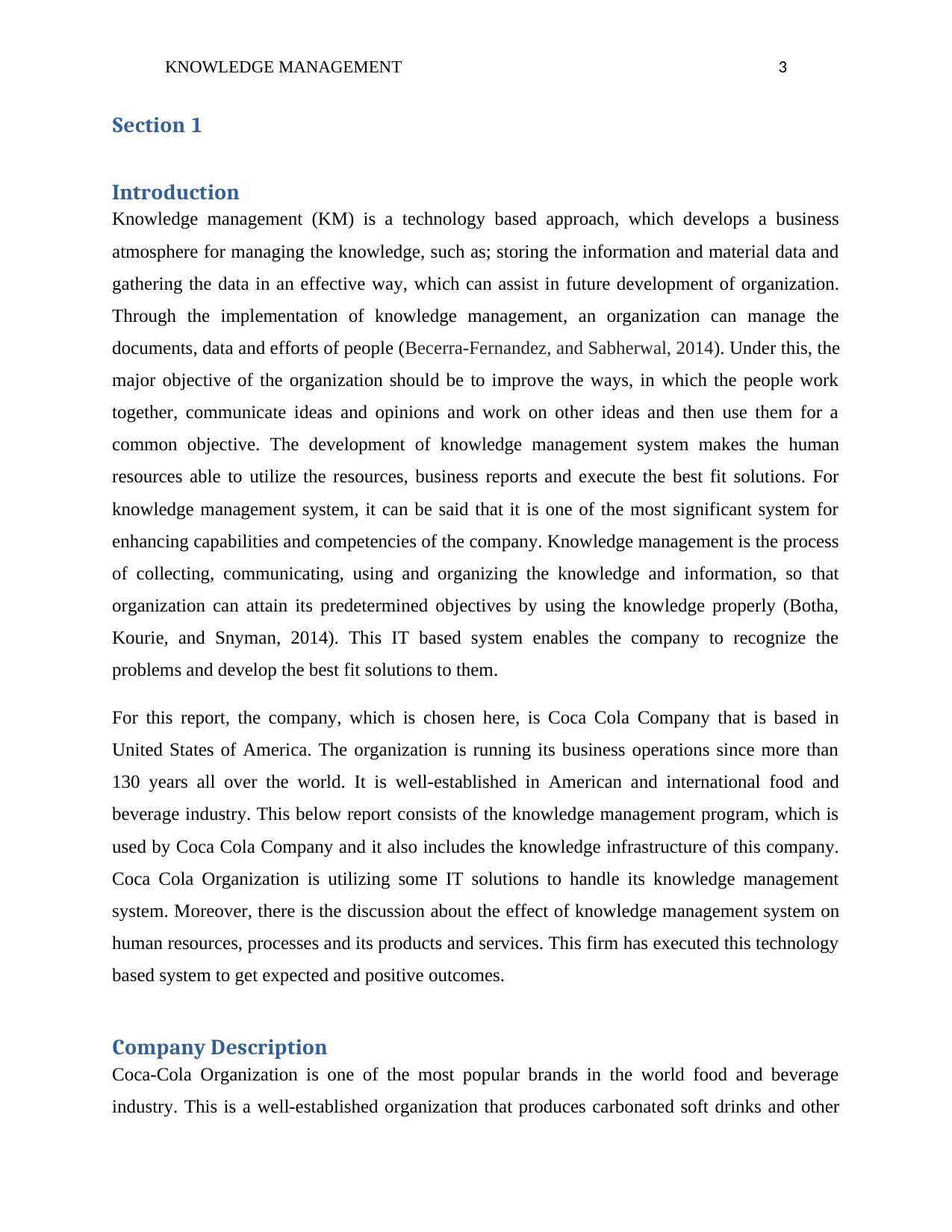
KNOWLEDGE MANAGEMENT 3
Section 1
Introduction
Knowledge management (KM) is a technology based approach, which develops a business
atmosphere for managing the knowledge, such as; storing the information and material data and
gathering the data in an effective way, which can assist in future development of organization.
Through the implementation of knowledge management, an organization can manage the
documents, data and efforts of people (Becerra-Fernandez, and Sabherwal, 2014). Under this, the
major objective of the organization should be to improve the ways, in which the people work
together, communicate ideas and opinions and work on other ideas and then use them for a
common objective. The development of knowledge management system makes the human
resources able to utilize the resources, business reports and execute the best fit solutions. For
knowledge management system, it can be said that it is one of the most significant system for
enhancing capabilities and competencies of the company. Knowledge management is the process
of collecting, communicating, using and organizing the knowledge and information, so that
organization can attain its predetermined objectives by using the knowledge properly (Botha,
Kourie, and Snyman, 2014). This IT based system enables the company to recognize the
problems and develop the best fit solutions to them.
For this report, the company, which is chosen here, is Coca Cola Company that is based in
United States of America. The organization is running its business operations since more than
130 years all over the world. It is well-established in American and international food and
beverage industry. This below report consists of the knowledge management program, which is
used by Coca Cola Company and it also includes the knowledge infrastructure of this company.
Coca Cola Organization is utilizing some IT solutions to handle its knowledge management
system. Moreover, there is the discussion about the effect of knowledge management system on
human resources, processes and its products and services. This firm has executed this technology
based system to get expected and positive outcomes.
Company Description
Coca-Cola Organization is one of the most popular brands in the world food and beverage
industry. This is a well-established organization that produces carbonated soft drinks and other
Section 1
Introduction
Knowledge management (KM) is a technology based approach, which develops a business
atmosphere for managing the knowledge, such as; storing the information and material data and
gathering the data in an effective way, which can assist in future development of organization.
Through the implementation of knowledge management, an organization can manage the
documents, data and efforts of people (Becerra-Fernandez, and Sabherwal, 2014). Under this, the
major objective of the organization should be to improve the ways, in which the people work
together, communicate ideas and opinions and work on other ideas and then use them for a
common objective. The development of knowledge management system makes the human
resources able to utilize the resources, business reports and execute the best fit solutions. For
knowledge management system, it can be said that it is one of the most significant system for
enhancing capabilities and competencies of the company. Knowledge management is the process
of collecting, communicating, using and organizing the knowledge and information, so that
organization can attain its predetermined objectives by using the knowledge properly (Botha,
Kourie, and Snyman, 2014). This IT based system enables the company to recognize the
problems and develop the best fit solutions to them.
For this report, the company, which is chosen here, is Coca Cola Company that is based in
United States of America. The organization is running its business operations since more than
130 years all over the world. It is well-established in American and international food and
beverage industry. This below report consists of the knowledge management program, which is
used by Coca Cola Company and it also includes the knowledge infrastructure of this company.
Coca Cola Organization is utilizing some IT solutions to handle its knowledge management
system. Moreover, there is the discussion about the effect of knowledge management system on
human resources, processes and its products and services. This firm has executed this technology
based system to get expected and positive outcomes.
Company Description
Coca-Cola Organization is one of the most popular brands in the world food and beverage
industry. This is a well-established organization that produces carbonated soft drinks and other
⊘ This is a preview!⊘
Do you want full access?
Subscribe today to unlock all pages.

Trusted by 1+ million students worldwide
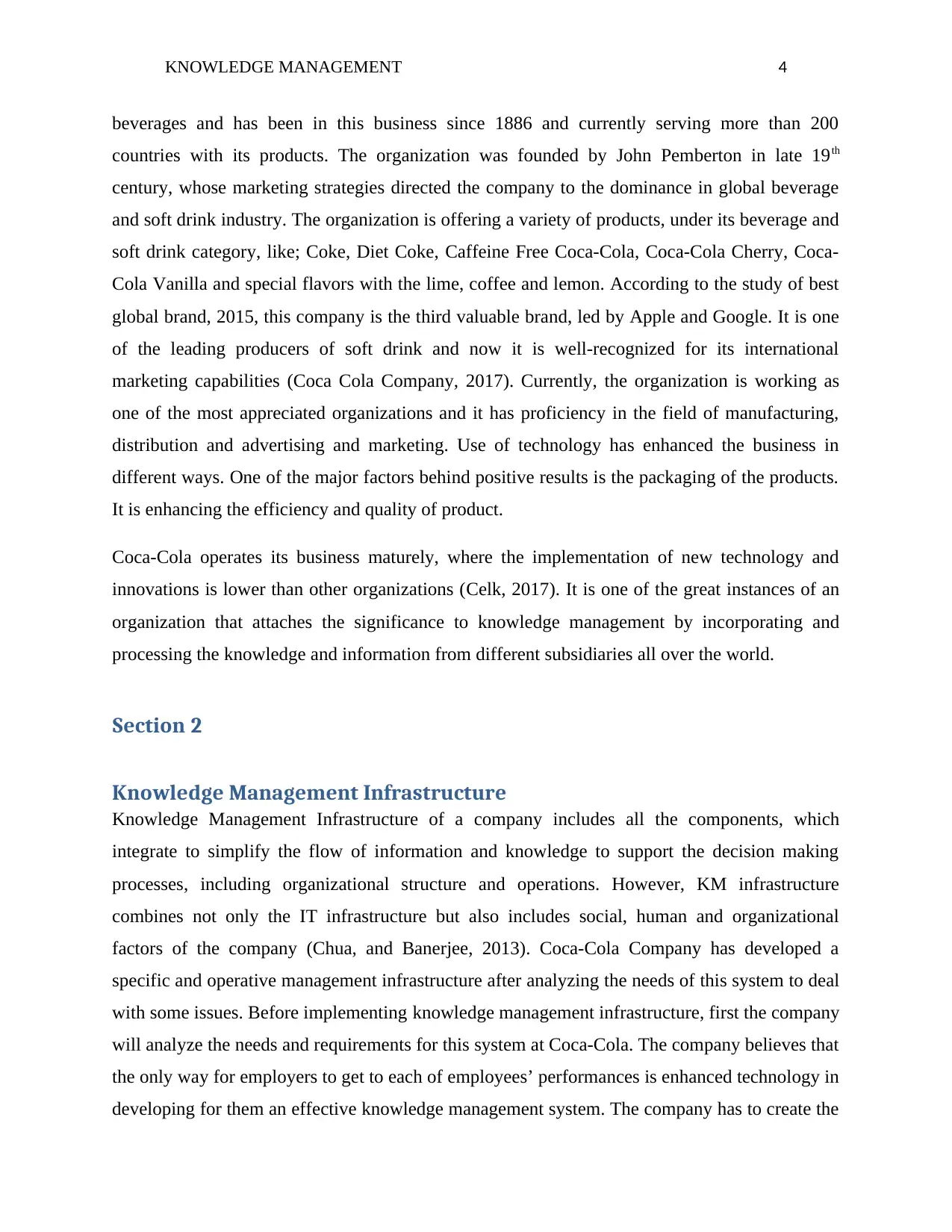
KNOWLEDGE MANAGEMENT 4
beverages and has been in this business since 1886 and currently serving more than 200
countries with its products. The organization was founded by John Pemberton in late 19th
century, whose marketing strategies directed the company to the dominance in global beverage
and soft drink industry. The organization is offering a variety of products, under its beverage and
soft drink category, like; Coke, Diet Coke, Caffeine Free Coca-Cola, Coca-Cola Cherry, Coca-
Cola Vanilla and special flavors with the lime, coffee and lemon. According to the study of best
global brand, 2015, this company is the third valuable brand, led by Apple and Google. It is one
of the leading producers of soft drink and now it is well-recognized for its international
marketing capabilities (Coca Cola Company, 2017). Currently, the organization is working as
one of the most appreciated organizations and it has proficiency in the field of manufacturing,
distribution and advertising and marketing. Use of technology has enhanced the business in
different ways. One of the major factors behind positive results is the packaging of the products.
It is enhancing the efficiency and quality of product.
Coca-Cola operates its business maturely, where the implementation of new technology and
innovations is lower than other organizations (Celk, 2017). It is one of the great instances of an
organization that attaches the significance to knowledge management by incorporating and
processing the knowledge and information from different subsidiaries all over the world.
Section 2
Knowledge Management Infrastructure
Knowledge Management Infrastructure of a company includes all the components, which
integrate to simplify the flow of information and knowledge to support the decision making
processes, including organizational structure and operations. However, KM infrastructure
combines not only the IT infrastructure but also includes social, human and organizational
factors of the company (Chua, and Banerjee, 2013). Coca-Cola Company has developed a
specific and operative management infrastructure after analyzing the needs of this system to deal
with some issues. Before implementing knowledge management infrastructure, first the company
will analyze the needs and requirements for this system at Coca-Cola. The company believes that
the only way for employers to get to each of employees’ performances is enhanced technology in
developing for them an effective knowledge management system. The company has to create the
beverages and has been in this business since 1886 and currently serving more than 200
countries with its products. The organization was founded by John Pemberton in late 19th
century, whose marketing strategies directed the company to the dominance in global beverage
and soft drink industry. The organization is offering a variety of products, under its beverage and
soft drink category, like; Coke, Diet Coke, Caffeine Free Coca-Cola, Coca-Cola Cherry, Coca-
Cola Vanilla and special flavors with the lime, coffee and lemon. According to the study of best
global brand, 2015, this company is the third valuable brand, led by Apple and Google. It is one
of the leading producers of soft drink and now it is well-recognized for its international
marketing capabilities (Coca Cola Company, 2017). Currently, the organization is working as
one of the most appreciated organizations and it has proficiency in the field of manufacturing,
distribution and advertising and marketing. Use of technology has enhanced the business in
different ways. One of the major factors behind positive results is the packaging of the products.
It is enhancing the efficiency and quality of product.
Coca-Cola operates its business maturely, where the implementation of new technology and
innovations is lower than other organizations (Celk, 2017). It is one of the great instances of an
organization that attaches the significance to knowledge management by incorporating and
processing the knowledge and information from different subsidiaries all over the world.
Section 2
Knowledge Management Infrastructure
Knowledge Management Infrastructure of a company includes all the components, which
integrate to simplify the flow of information and knowledge to support the decision making
processes, including organizational structure and operations. However, KM infrastructure
combines not only the IT infrastructure but also includes social, human and organizational
factors of the company (Chua, and Banerjee, 2013). Coca-Cola Company has developed a
specific and operative management infrastructure after analyzing the needs of this system to deal
with some issues. Before implementing knowledge management infrastructure, first the company
will analyze the needs and requirements for this system at Coca-Cola. The company believes that
the only way for employers to get to each of employees’ performances is enhanced technology in
developing for them an effective knowledge management system. The company has to create the
Paraphrase This Document
Need a fresh take? Get an instant paraphrase of this document with our AI Paraphraser
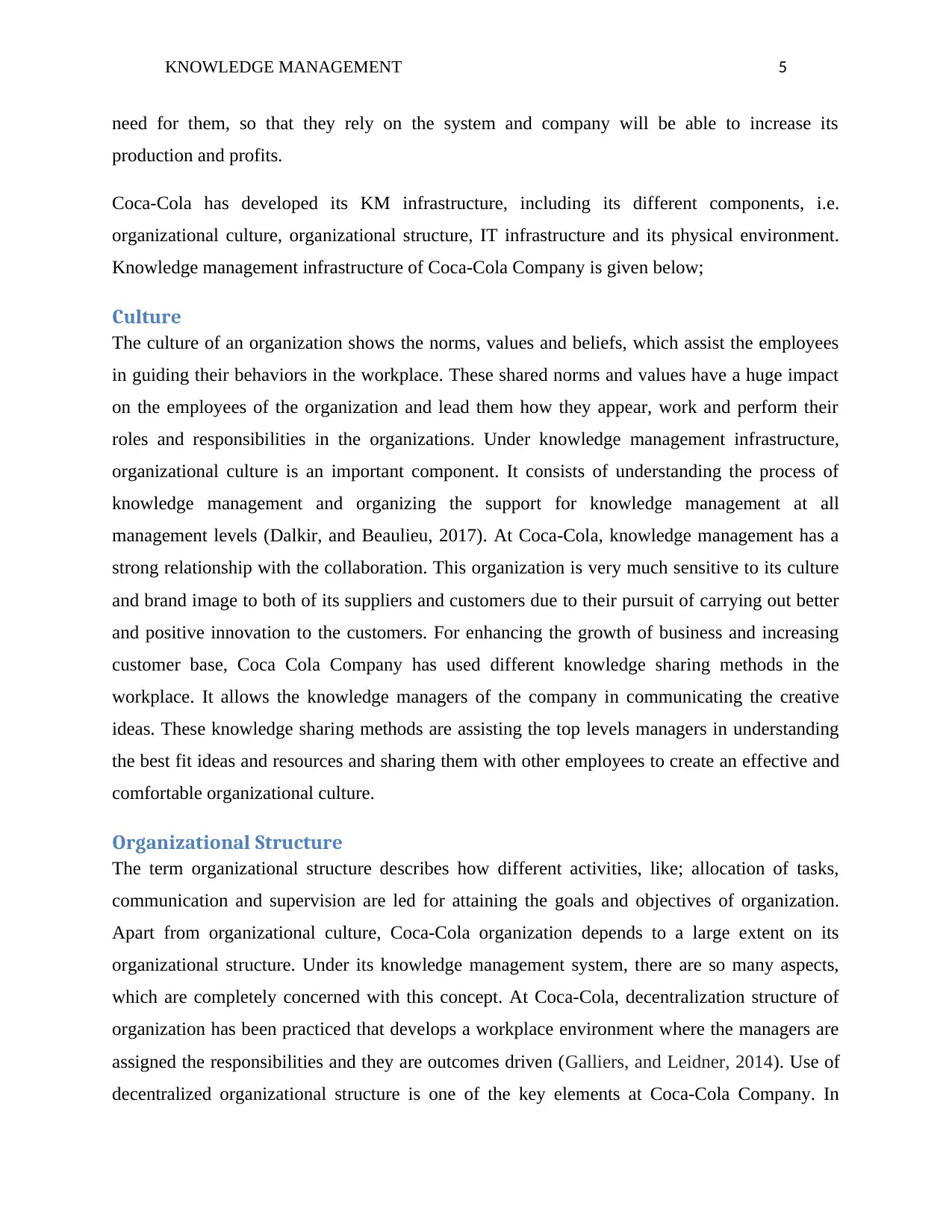
KNOWLEDGE MANAGEMENT 5
need for them, so that they rely on the system and company will be able to increase its
production and profits.
Coca-Cola has developed its KM infrastructure, including its different components, i.e.
organizational culture, organizational structure, IT infrastructure and its physical environment.
Knowledge management infrastructure of Coca-Cola Company is given below;
Culture
The culture of an organization shows the norms, values and beliefs, which assist the employees
in guiding their behaviors in the workplace. These shared norms and values have a huge impact
on the employees of the organization and lead them how they appear, work and perform their
roles and responsibilities in the organizations. Under knowledge management infrastructure,
organizational culture is an important component. It consists of understanding the process of
knowledge management and organizing the support for knowledge management at all
management levels (Dalkir, and Beaulieu, 2017). At Coca-Cola, knowledge management has a
strong relationship with the collaboration. This organization is very much sensitive to its culture
and brand image to both of its suppliers and customers due to their pursuit of carrying out better
and positive innovation to the customers. For enhancing the growth of business and increasing
customer base, Coca Cola Company has used different knowledge sharing methods in the
workplace. It allows the knowledge managers of the company in communicating the creative
ideas. These knowledge sharing methods are assisting the top levels managers in understanding
the best fit ideas and resources and sharing them with other employees to create an effective and
comfortable organizational culture.
Organizational Structure
The term organizational structure describes how different activities, like; allocation of tasks,
communication and supervision are led for attaining the goals and objectives of organization.
Apart from organizational culture, Coca-Cola organization depends to a large extent on its
organizational structure. Under its knowledge management system, there are so many aspects,
which are completely concerned with this concept. At Coca-Cola, decentralization structure of
organization has been practiced that develops a workplace environment where the managers are
assigned the responsibilities and they are outcomes driven (Galliers, and Leidner, 2014). Use of
decentralized organizational structure is one of the key elements at Coca-Cola Company. In
need for them, so that they rely on the system and company will be able to increase its
production and profits.
Coca-Cola has developed its KM infrastructure, including its different components, i.e.
organizational culture, organizational structure, IT infrastructure and its physical environment.
Knowledge management infrastructure of Coca-Cola Company is given below;
Culture
The culture of an organization shows the norms, values and beliefs, which assist the employees
in guiding their behaviors in the workplace. These shared norms and values have a huge impact
on the employees of the organization and lead them how they appear, work and perform their
roles and responsibilities in the organizations. Under knowledge management infrastructure,
organizational culture is an important component. It consists of understanding the process of
knowledge management and organizing the support for knowledge management at all
management levels (Dalkir, and Beaulieu, 2017). At Coca-Cola, knowledge management has a
strong relationship with the collaboration. This organization is very much sensitive to its culture
and brand image to both of its suppliers and customers due to their pursuit of carrying out better
and positive innovation to the customers. For enhancing the growth of business and increasing
customer base, Coca Cola Company has used different knowledge sharing methods in the
workplace. It allows the knowledge managers of the company in communicating the creative
ideas. These knowledge sharing methods are assisting the top levels managers in understanding
the best fit ideas and resources and sharing them with other employees to create an effective and
comfortable organizational culture.
Organizational Structure
The term organizational structure describes how different activities, like; allocation of tasks,
communication and supervision are led for attaining the goals and objectives of organization.
Apart from organizational culture, Coca-Cola organization depends to a large extent on its
organizational structure. Under its knowledge management system, there are so many aspects,
which are completely concerned with this concept. At Coca-Cola, decentralization structure of
organization has been practiced that develops a workplace environment where the managers are
assigned the responsibilities and they are outcomes driven (Galliers, and Leidner, 2014). Use of
decentralized organizational structure is one of the key elements at Coca-Cola Company. In

KNOWLEDGE MANAGEMENT 6
addition to this, the large liberation of some specific business areas and of the departments shows
that the middle level of management has sectorial proficiency.
On the basis of this structure, the company is following the principle that the employees, who are
closer to the problems, are closer to solution to them. Under the knowledge management system
at Coca-Cola Company, embedded knowledge plays a vital role. This KM system allows the
managers to use the data and information of their workplace and its environment. Furthermore,
this also helps the organization in analyzing the structures and working processes of its human
resources.
One of the major strengths of Coca-Cola Company over other small beverage company is the
knowledge, which each part of the organization has created with the passage of time and that can
be used by other people in the organization. It has nurtured its organizational structure and
culture through tacit knowledge of its employees. Implanted knowledge at Coca-Cola Company
provides different rules and regulations, which need to be complied with. The top management at
Coca-Cola Company gives a task schedule to its people (Hallin, and Marnburg, 2008). Through
this, they are able to understand the schedule to coordinate with their external and internal
stakeholders, like; customers, suppliers, manufacturers, shareholders etc. In addition to this,
Coca-Cola is executing the structural knowledge management system, which enables its
management and top managers to access the previous reports and data, where the knowledge is
secured.
IT Infrastructure
Knowledge management structure of the company is also enabled by the IT infrastructure of that
company. However, some information systems and technologies are directly established to go
ahead with the knowledge management, overall It structure of organization that is created to
assist the requirements of management information system (Hays, 2010). The IT infrastructure of
the organization combines different elements, like; storage, data processing, communication
systems and technologies and practices, which process them to work. Coca-Cola Company is
implementing effective information technology tools for connecting the people from different
departments, like; finance, production, distribution, marketing etc. By implementing the
electronic data interchange technology that is incorporated in the information system of
company, the employees are able to access the operational data, such as; sales data and figures,
addition to this, the large liberation of some specific business areas and of the departments shows
that the middle level of management has sectorial proficiency.
On the basis of this structure, the company is following the principle that the employees, who are
closer to the problems, are closer to solution to them. Under the knowledge management system
at Coca-Cola Company, embedded knowledge plays a vital role. This KM system allows the
managers to use the data and information of their workplace and its environment. Furthermore,
this also helps the organization in analyzing the structures and working processes of its human
resources.
One of the major strengths of Coca-Cola Company over other small beverage company is the
knowledge, which each part of the organization has created with the passage of time and that can
be used by other people in the organization. It has nurtured its organizational structure and
culture through tacit knowledge of its employees. Implanted knowledge at Coca-Cola Company
provides different rules and regulations, which need to be complied with. The top management at
Coca-Cola Company gives a task schedule to its people (Hallin, and Marnburg, 2008). Through
this, they are able to understand the schedule to coordinate with their external and internal
stakeholders, like; customers, suppliers, manufacturers, shareholders etc. In addition to this,
Coca-Cola is executing the structural knowledge management system, which enables its
management and top managers to access the previous reports and data, where the knowledge is
secured.
IT Infrastructure
Knowledge management structure of the company is also enabled by the IT infrastructure of that
company. However, some information systems and technologies are directly established to go
ahead with the knowledge management, overall It structure of organization that is created to
assist the requirements of management information system (Hays, 2010). The IT infrastructure of
the organization combines different elements, like; storage, data processing, communication
systems and technologies and practices, which process them to work. Coca-Cola Company is
implementing effective information technology tools for connecting the people from different
departments, like; finance, production, distribution, marketing etc. By implementing the
electronic data interchange technology that is incorporated in the information system of
company, the employees are able to access the operational data, such as; sales data and figures,
⊘ This is a preview!⊘
Do you want full access?
Subscribe today to unlock all pages.

Trusted by 1+ million students worldwide
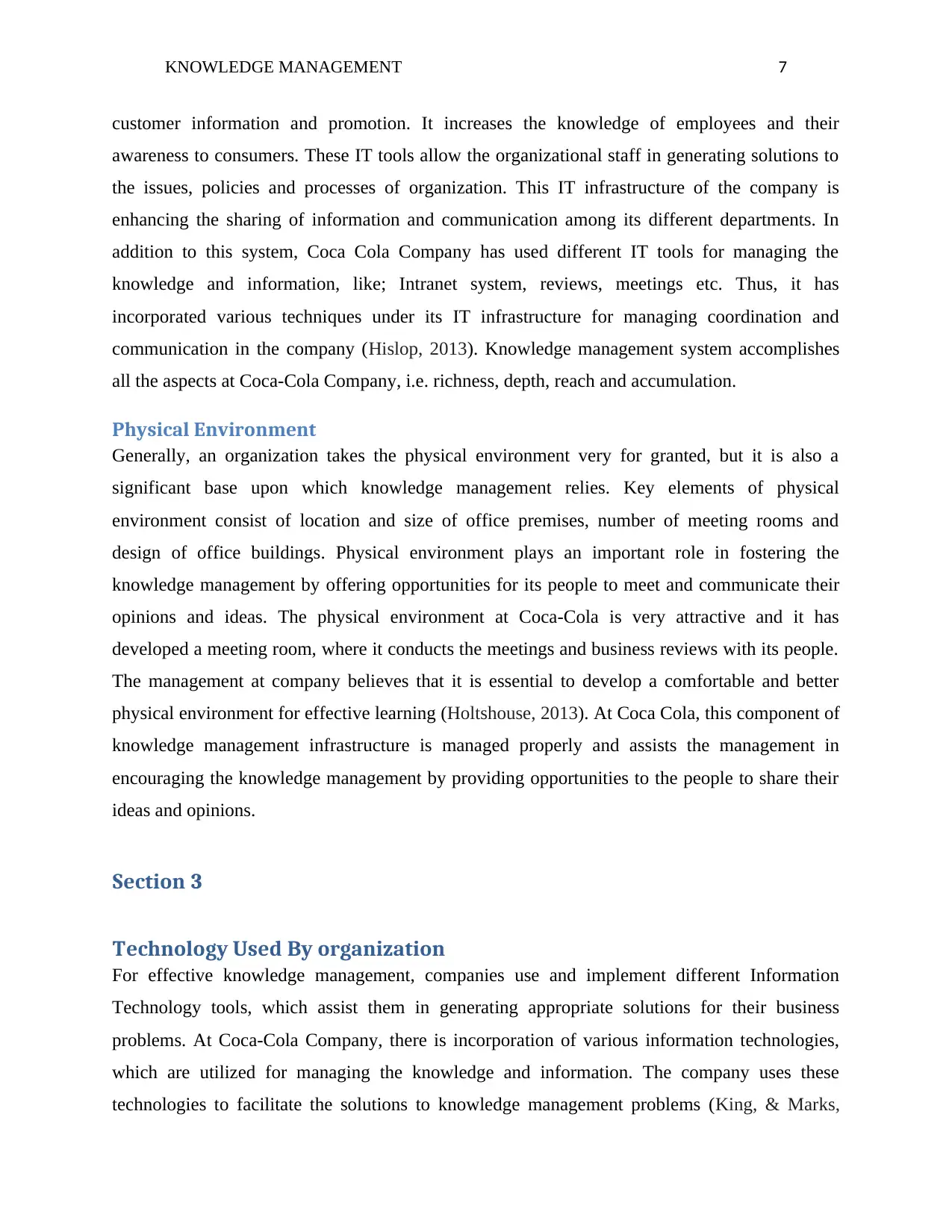
KNOWLEDGE MANAGEMENT 7
customer information and promotion. It increases the knowledge of employees and their
awareness to consumers. These IT tools allow the organizational staff in generating solutions to
the issues, policies and processes of organization. This IT infrastructure of the company is
enhancing the sharing of information and communication among its different departments. In
addition to this system, Coca Cola Company has used different IT tools for managing the
knowledge and information, like; Intranet system, reviews, meetings etc. Thus, it has
incorporated various techniques under its IT infrastructure for managing coordination and
communication in the company (Hislop, 2013). Knowledge management system accomplishes
all the aspects at Coca-Cola Company, i.e. richness, depth, reach and accumulation.
Physical Environment
Generally, an organization takes the physical environment very for granted, but it is also a
significant base upon which knowledge management relies. Key elements of physical
environment consist of location and size of office premises, number of meeting rooms and
design of office buildings. Physical environment plays an important role in fostering the
knowledge management by offering opportunities for its people to meet and communicate their
opinions and ideas. The physical environment at Coca-Cola is very attractive and it has
developed a meeting room, where it conducts the meetings and business reviews with its people.
The management at company believes that it is essential to develop a comfortable and better
physical environment for effective learning (Holtshouse, 2013). At Coca Cola, this component of
knowledge management infrastructure is managed properly and assists the management in
encouraging the knowledge management by providing opportunities to the people to share their
ideas and opinions.
Section 3
Technology Used By organization
For effective knowledge management, companies use and implement different Information
Technology tools, which assist them in generating appropriate solutions for their business
problems. At Coca-Cola Company, there is incorporation of various information technologies,
which are utilized for managing the knowledge and information. The company uses these
technologies to facilitate the solutions to knowledge management problems (King, & Marks,
customer information and promotion. It increases the knowledge of employees and their
awareness to consumers. These IT tools allow the organizational staff in generating solutions to
the issues, policies and processes of organization. This IT infrastructure of the company is
enhancing the sharing of information and communication among its different departments. In
addition to this system, Coca Cola Company has used different IT tools for managing the
knowledge and information, like; Intranet system, reviews, meetings etc. Thus, it has
incorporated various techniques under its IT infrastructure for managing coordination and
communication in the company (Hislop, 2013). Knowledge management system accomplishes
all the aspects at Coca-Cola Company, i.e. richness, depth, reach and accumulation.
Physical Environment
Generally, an organization takes the physical environment very for granted, but it is also a
significant base upon which knowledge management relies. Key elements of physical
environment consist of location and size of office premises, number of meeting rooms and
design of office buildings. Physical environment plays an important role in fostering the
knowledge management by offering opportunities for its people to meet and communicate their
opinions and ideas. The physical environment at Coca-Cola is very attractive and it has
developed a meeting room, where it conducts the meetings and business reviews with its people.
The management at company believes that it is essential to develop a comfortable and better
physical environment for effective learning (Holtshouse, 2013). At Coca Cola, this component of
knowledge management infrastructure is managed properly and assists the management in
encouraging the knowledge management by providing opportunities to the people to share their
ideas and opinions.
Section 3
Technology Used By organization
For effective knowledge management, companies use and implement different Information
Technology tools, which assist them in generating appropriate solutions for their business
problems. At Coca-Cola Company, there is incorporation of various information technologies,
which are utilized for managing the knowledge and information. The company uses these
technologies to facilitate the solutions to knowledge management problems (King, & Marks,
Paraphrase This Document
Need a fresh take? Get an instant paraphrase of this document with our AI Paraphraser
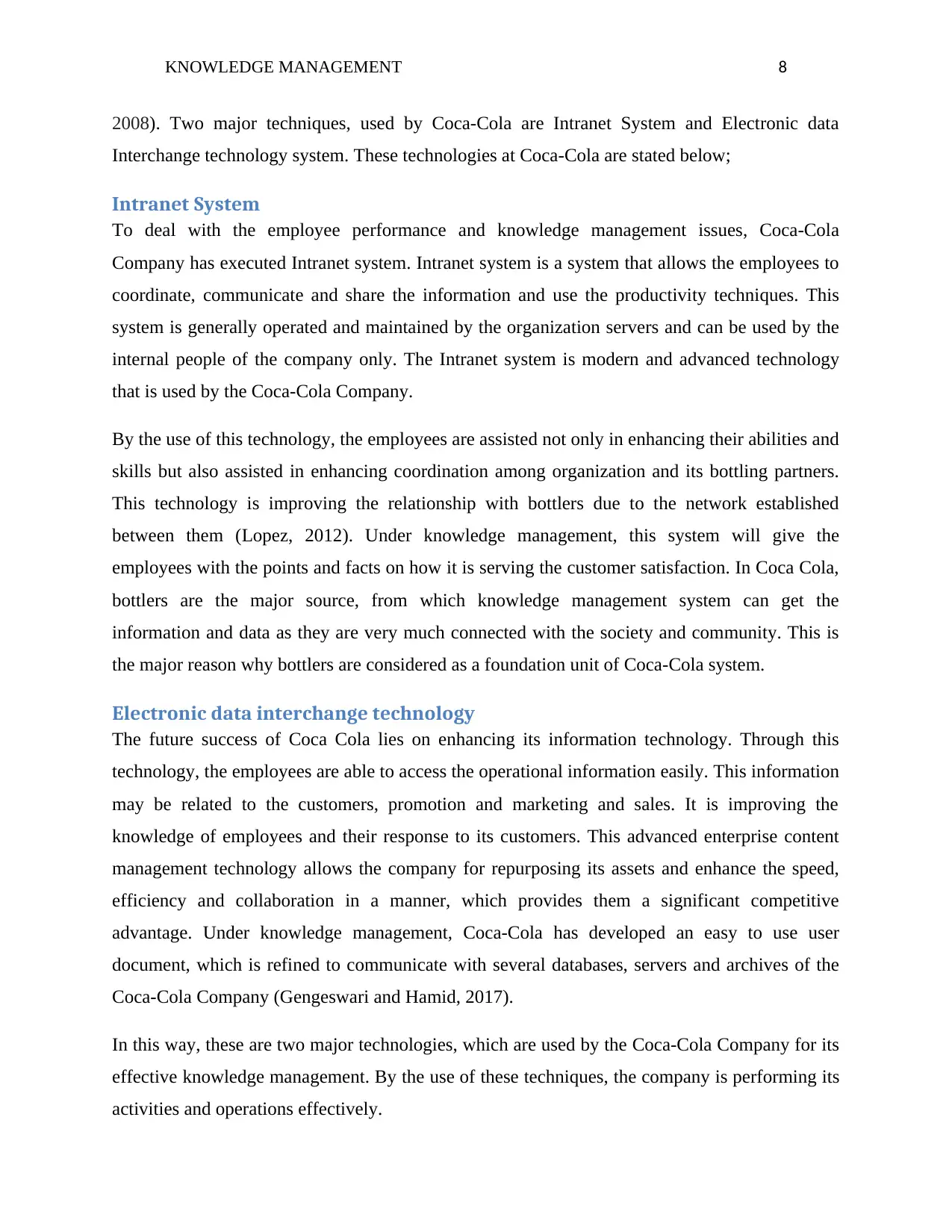
KNOWLEDGE MANAGEMENT 8
2008). Two major techniques, used by Coca-Cola are Intranet System and Electronic data
Interchange technology system. These technologies at Coca-Cola are stated below;
Intranet System
To deal with the employee performance and knowledge management issues, Coca-Cola
Company has executed Intranet system. Intranet system is a system that allows the employees to
coordinate, communicate and share the information and use the productivity techniques. This
system is generally operated and maintained by the organization servers and can be used by the
internal people of the company only. The Intranet system is modern and advanced technology
that is used by the Coca-Cola Company.
By the use of this technology, the employees are assisted not only in enhancing their abilities and
skills but also assisted in enhancing coordination among organization and its bottling partners.
This technology is improving the relationship with bottlers due to the network established
between them (Lopez, 2012). Under knowledge management, this system will give the
employees with the points and facts on how it is serving the customer satisfaction. In Coca Cola,
bottlers are the major source, from which knowledge management system can get the
information and data as they are very much connected with the society and community. This is
the major reason why bottlers are considered as a foundation unit of Coca-Cola system.
Electronic data interchange technology
The future success of Coca Cola lies on enhancing its information technology. Through this
technology, the employees are able to access the operational information easily. This information
may be related to the customers, promotion and marketing and sales. It is improving the
knowledge of employees and their response to its customers. This advanced enterprise content
management technology allows the company for repurposing its assets and enhance the speed,
efficiency and collaboration in a manner, which provides them a significant competitive
advantage. Under knowledge management, Coca-Cola has developed an easy to use user
document, which is refined to communicate with several databases, servers and archives of the
Coca-Cola Company (Gengeswari and Hamid, 2017).
In this way, these are two major technologies, which are used by the Coca-Cola Company for its
effective knowledge management. By the use of these techniques, the company is performing its
activities and operations effectively.
2008). Two major techniques, used by Coca-Cola are Intranet System and Electronic data
Interchange technology system. These technologies at Coca-Cola are stated below;
Intranet System
To deal with the employee performance and knowledge management issues, Coca-Cola
Company has executed Intranet system. Intranet system is a system that allows the employees to
coordinate, communicate and share the information and use the productivity techniques. This
system is generally operated and maintained by the organization servers and can be used by the
internal people of the company only. The Intranet system is modern and advanced technology
that is used by the Coca-Cola Company.
By the use of this technology, the employees are assisted not only in enhancing their abilities and
skills but also assisted in enhancing coordination among organization and its bottling partners.
This technology is improving the relationship with bottlers due to the network established
between them (Lopez, 2012). Under knowledge management, this system will give the
employees with the points and facts on how it is serving the customer satisfaction. In Coca Cola,
bottlers are the major source, from which knowledge management system can get the
information and data as they are very much connected with the society and community. This is
the major reason why bottlers are considered as a foundation unit of Coca-Cola system.
Electronic data interchange technology
The future success of Coca Cola lies on enhancing its information technology. Through this
technology, the employees are able to access the operational information easily. This information
may be related to the customers, promotion and marketing and sales. It is improving the
knowledge of employees and their response to its customers. This advanced enterprise content
management technology allows the company for repurposing its assets and enhance the speed,
efficiency and collaboration in a manner, which provides them a significant competitive
advantage. Under knowledge management, Coca-Cola has developed an easy to use user
document, which is refined to communicate with several databases, servers and archives of the
Coca-Cola Company (Gengeswari and Hamid, 2017).
In this way, these are two major technologies, which are used by the Coca-Cola Company for its
effective knowledge management. By the use of these techniques, the company is performing its
activities and operations effectively.

KNOWLEDGE MANAGEMENT 9
Section 4
Knowledge Management Systems
Knowledge management systems are the practices, which are created by combining different
technologies, which assist the knowledge management process of a company (Mirvis, Herrera,
Googins, and Albareda, 2016). In an organization, these systems can be categorized in four
types, which are given below;
Knowledge Capture System
Knowledge Application System
Knowledge Discovery System
Knowledge Sharing System
For Coca Cola Company, two of above systems are stated below;
Knowledge Application System
Knowledge application system is a system, which can be utilized for maintaining the important
knowledge and information on the company. It is an important system, which helps the process
through which some of its employees use the knowledge owned by other employees without
receiving and learning the knowledge (Macharia, and Ismail, 2015). There are two types of this
system, i.e. routines and direction. At Coca Cola Company, the knowledge managers have
pursued routine as its application system. Under this system, Coca-Cola Company has included
the knowledge and information in its routine work processes. In this way, it is able to guide the
employee behavior and perform their duties and responsibilities accordingly. The management at
this organization believes that application system under knowledge management should be
efficient because it is most significant component of this process. In addition to norms and rules,
the organization uses various applications and software to transfer and apply the knowledge, like;
enterprise resource planning (ERP), enterprise content management system and CRM (Smith,
and Lyles, 2017).
Knowledge Sharing Systems
This is another system under the process of knowledge management, through which implied
knowledge and information is shared with the people in an organization. This system of
knowledge sharing can be positioned among different departments and groups of organization.
Section 4
Knowledge Management Systems
Knowledge management systems are the practices, which are created by combining different
technologies, which assist the knowledge management process of a company (Mirvis, Herrera,
Googins, and Albareda, 2016). In an organization, these systems can be categorized in four
types, which are given below;
Knowledge Capture System
Knowledge Application System
Knowledge Discovery System
Knowledge Sharing System
For Coca Cola Company, two of above systems are stated below;
Knowledge Application System
Knowledge application system is a system, which can be utilized for maintaining the important
knowledge and information on the company. It is an important system, which helps the process
through which some of its employees use the knowledge owned by other employees without
receiving and learning the knowledge (Macharia, and Ismail, 2015). There are two types of this
system, i.e. routines and direction. At Coca Cola Company, the knowledge managers have
pursued routine as its application system. Under this system, Coca-Cola Company has included
the knowledge and information in its routine work processes. In this way, it is able to guide the
employee behavior and perform their duties and responsibilities accordingly. The management at
this organization believes that application system under knowledge management should be
efficient because it is most significant component of this process. In addition to norms and rules,
the organization uses various applications and software to transfer and apply the knowledge, like;
enterprise resource planning (ERP), enterprise content management system and CRM (Smith,
and Lyles, 2017).
Knowledge Sharing Systems
This is another system under the process of knowledge management, through which implied
knowledge and information is shared with the people in an organization. This system of
knowledge sharing can be positioned among different departments and groups of organization.
⊘ This is a preview!⊘
Do you want full access?
Subscribe today to unlock all pages.

Trusted by 1+ million students worldwide

KNOWLEDGE MANAGEMENT 10
For sharing the knowledge and material information, Coca Cola Company is using effective tools
and technologies, like; intranet system and electronic data interchange. In addition to this, it is
utilizing the embedded knowledge, which supports the company is situation planning and
understanding the employees (Noell, 2014). This situational planning allows the managers in
developing a structure for operating the information system properly. By using the above given
technologies, the company is able to share its work procedures and guidelines with its
employees. The knowledge sharing system of Coca-Cola has assisted the management to
communicate with all the levels of employees.
Section 5
Impact of knowledge management solutions on: people, processes,
products and organization performance
In an organization, the knowledge is developed by combining for components of the
organization, i.e. people, processes, practice and technology. The knowledge management
solutions, implemented by Coca-Cola have a large impact on its people, processes, products and
performance, which are given below;
People
Under knowledge management process, people are the key sources of information. Through
knowledge management system, the people at Coca-Cola Company are able to develop and
acquire the information and learn from that and teach others, so that organization can be more
innovative and generate new knowledge. This system at Coca-Cola allows the managers and
employees to acquire deep understanding to manage organizational resources and employees
(Rasheed, Subhan, Ahmed, and Ibrahim, 2015).
Processes
Processes are the structured activities that direct the company and its people towards its
objectives. Through effective knowledge management implementation, Coca-Cola organization
is able to enhance the productivity and efficiency of its processes, like; production, supply chain,
marketing and advertising. Intranet system allows all the authorized departments to access the
required information. They can contact with its all the employees and departments all over the
For sharing the knowledge and material information, Coca Cola Company is using effective tools
and technologies, like; intranet system and electronic data interchange. In addition to this, it is
utilizing the embedded knowledge, which supports the company is situation planning and
understanding the employees (Noell, 2014). This situational planning allows the managers in
developing a structure for operating the information system properly. By using the above given
technologies, the company is able to share its work procedures and guidelines with its
employees. The knowledge sharing system of Coca-Cola has assisted the management to
communicate with all the levels of employees.
Section 5
Impact of knowledge management solutions on: people, processes,
products and organization performance
In an organization, the knowledge is developed by combining for components of the
organization, i.e. people, processes, practice and technology. The knowledge management
solutions, implemented by Coca-Cola have a large impact on its people, processes, products and
performance, which are given below;
People
Under knowledge management process, people are the key sources of information. Through
knowledge management system, the people at Coca-Cola Company are able to develop and
acquire the information and learn from that and teach others, so that organization can be more
innovative and generate new knowledge. This system at Coca-Cola allows the managers and
employees to acquire deep understanding to manage organizational resources and employees
(Rasheed, Subhan, Ahmed, and Ibrahim, 2015).
Processes
Processes are the structured activities that direct the company and its people towards its
objectives. Through effective knowledge management implementation, Coca-Cola organization
is able to enhance the productivity and efficiency of its processes, like; production, supply chain,
marketing and advertising. Intranet system allows all the authorized departments to access the
required information. They can contact with its all the employees and departments all over the
Paraphrase This Document
Need a fresh take? Get an instant paraphrase of this document with our AI Paraphraser
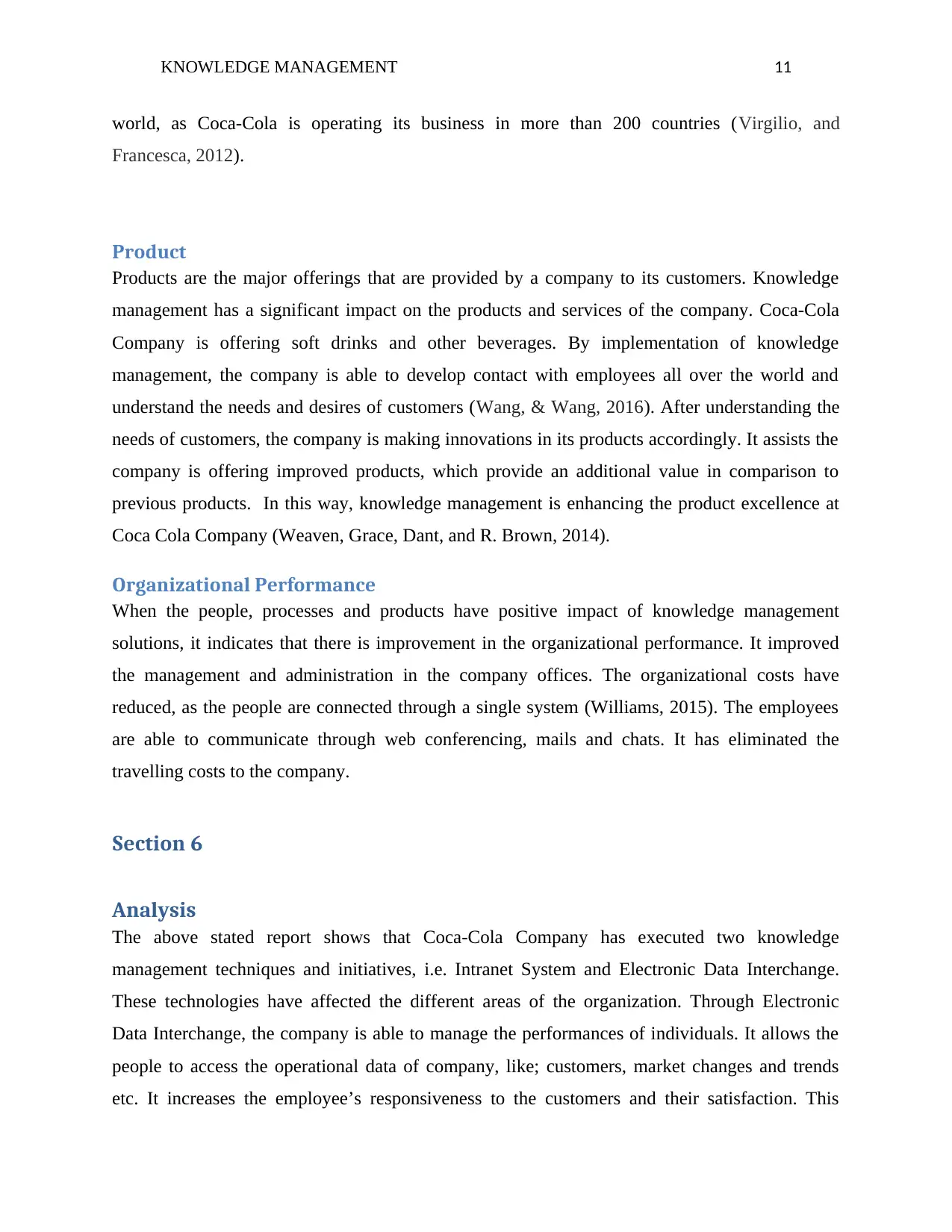
KNOWLEDGE MANAGEMENT 11
world, as Coca-Cola is operating its business in more than 200 countries (Virgilio, and
Francesca, 2012).
Product
Products are the major offerings that are provided by a company to its customers. Knowledge
management has a significant impact on the products and services of the company. Coca-Cola
Company is offering soft drinks and other beverages. By implementation of knowledge
management, the company is able to develop contact with employees all over the world and
understand the needs and desires of customers (Wang, & Wang, 2016). After understanding the
needs of customers, the company is making innovations in its products accordingly. It assists the
company is offering improved products, which provide an additional value in comparison to
previous products. In this way, knowledge management is enhancing the product excellence at
Coca Cola Company (Weaven, Grace, Dant, and R. Brown, 2014).
Organizational Performance
When the people, processes and products have positive impact of knowledge management
solutions, it indicates that there is improvement in the organizational performance. It improved
the management and administration in the company offices. The organizational costs have
reduced, as the people are connected through a single system (Williams, 2015). The employees
are able to communicate through web conferencing, mails and chats. It has eliminated the
travelling costs to the company.
Section 6
Analysis
The above stated report shows that Coca-Cola Company has executed two knowledge
management techniques and initiatives, i.e. Intranet System and Electronic Data Interchange.
These technologies have affected the different areas of the organization. Through Electronic
Data Interchange, the company is able to manage the performances of individuals. It allows the
people to access the operational data of company, like; customers, market changes and trends
etc. It increases the employee’s responsiveness to the customers and their satisfaction. This
world, as Coca-Cola is operating its business in more than 200 countries (Virgilio, and
Francesca, 2012).
Product
Products are the major offerings that are provided by a company to its customers. Knowledge
management has a significant impact on the products and services of the company. Coca-Cola
Company is offering soft drinks and other beverages. By implementation of knowledge
management, the company is able to develop contact with employees all over the world and
understand the needs and desires of customers (Wang, & Wang, 2016). After understanding the
needs of customers, the company is making innovations in its products accordingly. It assists the
company is offering improved products, which provide an additional value in comparison to
previous products. In this way, knowledge management is enhancing the product excellence at
Coca Cola Company (Weaven, Grace, Dant, and R. Brown, 2014).
Organizational Performance
When the people, processes and products have positive impact of knowledge management
solutions, it indicates that there is improvement in the organizational performance. It improved
the management and administration in the company offices. The organizational costs have
reduced, as the people are connected through a single system (Williams, 2015). The employees
are able to communicate through web conferencing, mails and chats. It has eliminated the
travelling costs to the company.
Section 6
Analysis
The above stated report shows that Coca-Cola Company has executed two knowledge
management techniques and initiatives, i.e. Intranet System and Electronic Data Interchange.
These technologies have affected the different areas of the organization. Through Electronic
Data Interchange, the company is able to manage the performances of individuals. It allows the
people to access the operational data of company, like; customers, market changes and trends
etc. It increases the employee’s responsiveness to the customers and their satisfaction. This
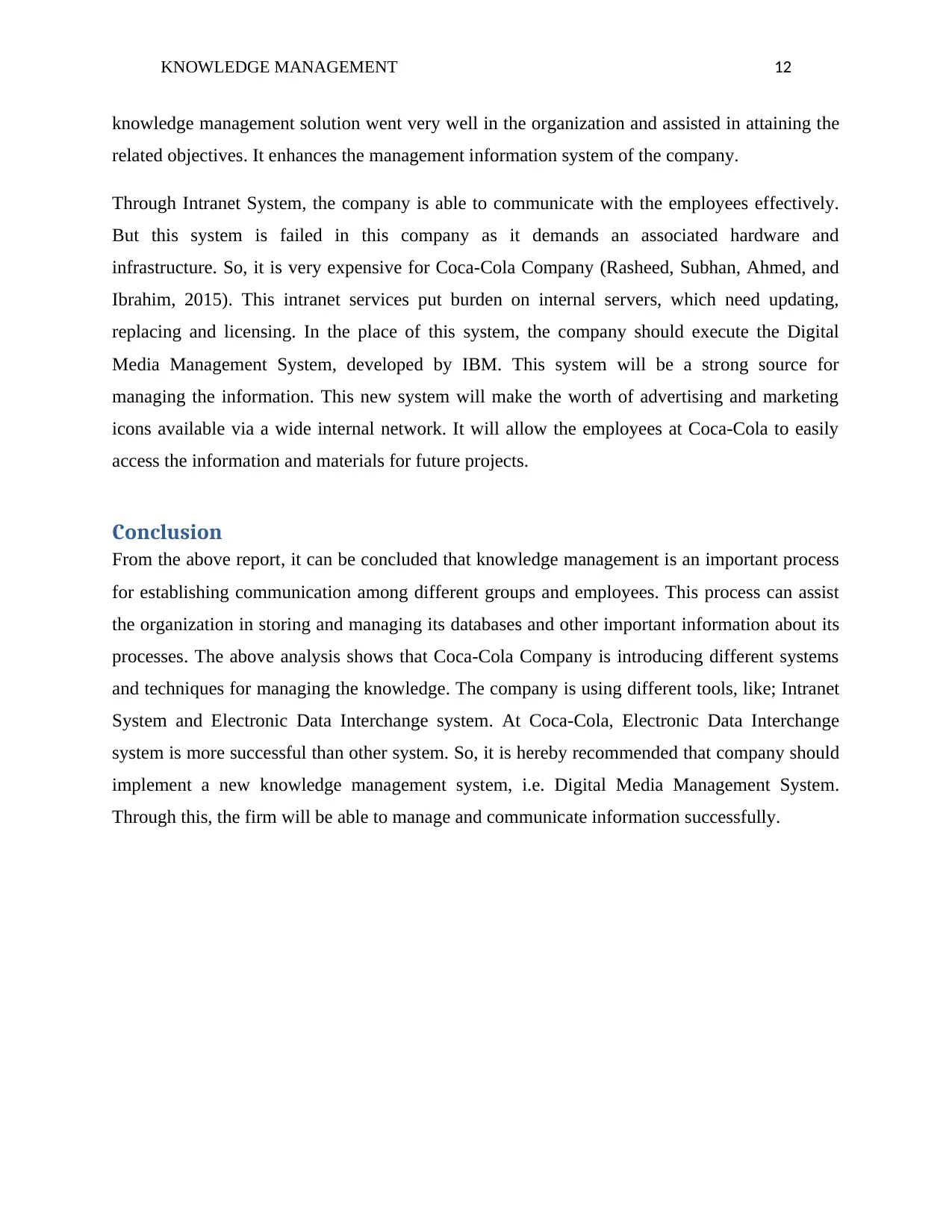
KNOWLEDGE MANAGEMENT 12
knowledge management solution went very well in the organization and assisted in attaining the
related objectives. It enhances the management information system of the company.
Through Intranet System, the company is able to communicate with the employees effectively.
But this system is failed in this company as it demands an associated hardware and
infrastructure. So, it is very expensive for Coca-Cola Company (Rasheed, Subhan, Ahmed, and
Ibrahim, 2015). This intranet services put burden on internal servers, which need updating,
replacing and licensing. In the place of this system, the company should execute the Digital
Media Management System, developed by IBM. This system will be a strong source for
managing the information. This new system will make the worth of advertising and marketing
icons available via a wide internal network. It will allow the employees at Coca-Cola to easily
access the information and materials for future projects.
Conclusion
From the above report, it can be concluded that knowledge management is an important process
for establishing communication among different groups and employees. This process can assist
the organization in storing and managing its databases and other important information about its
processes. The above analysis shows that Coca-Cola Company is introducing different systems
and techniques for managing the knowledge. The company is using different tools, like; Intranet
System and Electronic Data Interchange system. At Coca-Cola, Electronic Data Interchange
system is more successful than other system. So, it is hereby recommended that company should
implement a new knowledge management system, i.e. Digital Media Management System.
Through this, the firm will be able to manage and communicate information successfully.
knowledge management solution went very well in the organization and assisted in attaining the
related objectives. It enhances the management information system of the company.
Through Intranet System, the company is able to communicate with the employees effectively.
But this system is failed in this company as it demands an associated hardware and
infrastructure. So, it is very expensive for Coca-Cola Company (Rasheed, Subhan, Ahmed, and
Ibrahim, 2015). This intranet services put burden on internal servers, which need updating,
replacing and licensing. In the place of this system, the company should execute the Digital
Media Management System, developed by IBM. This system will be a strong source for
managing the information. This new system will make the worth of advertising and marketing
icons available via a wide internal network. It will allow the employees at Coca-Cola to easily
access the information and materials for future projects.
Conclusion
From the above report, it can be concluded that knowledge management is an important process
for establishing communication among different groups and employees. This process can assist
the organization in storing and managing its databases and other important information about its
processes. The above analysis shows that Coca-Cola Company is introducing different systems
and techniques for managing the knowledge. The company is using different tools, like; Intranet
System and Electronic Data Interchange system. At Coca-Cola, Electronic Data Interchange
system is more successful than other system. So, it is hereby recommended that company should
implement a new knowledge management system, i.e. Digital Media Management System.
Through this, the firm will be able to manage and communicate information successfully.
⊘ This is a preview!⊘
Do you want full access?
Subscribe today to unlock all pages.

Trusted by 1+ million students worldwide
1 out of 15
Related Documents
Your All-in-One AI-Powered Toolkit for Academic Success.
+13062052269
info@desklib.com
Available 24*7 on WhatsApp / Email
![[object Object]](/_next/static/media/star-bottom.7253800d.svg)
Unlock your academic potential
Copyright © 2020–2025 A2Z Services. All Rights Reserved. Developed and managed by ZUCOL.





